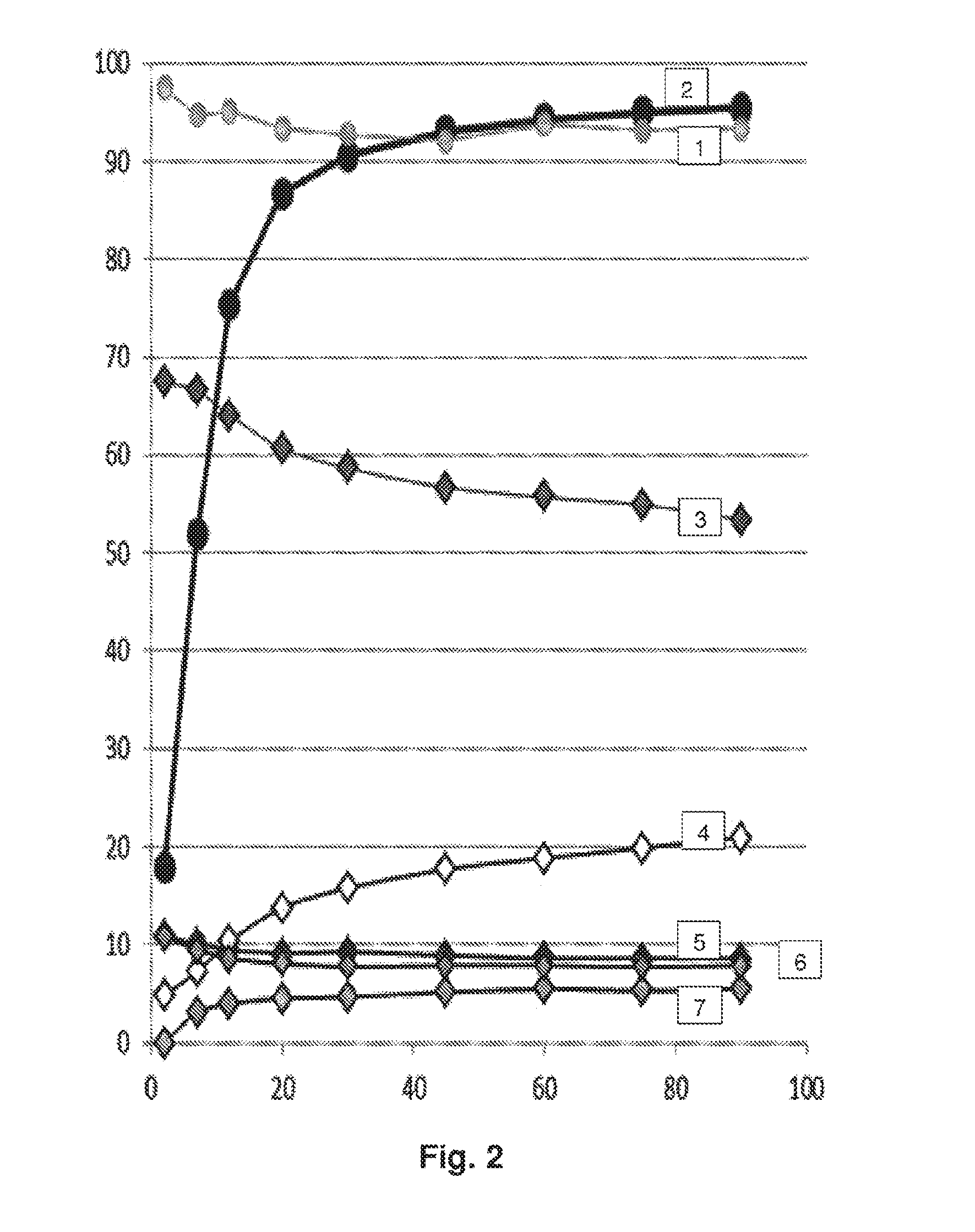Supported metal catalyst and use thereof for selective oxidation of glycerol
- Summary
- Abstract
- Description
- Claims
- Application Information
AI Technical Summary
Benefits of technology
Problems solved by technology
Method used
Image
Examples
example 1
Synthesis of a Support Pt / Sn Bimetal Catalyst
[0072]The supported catalyst is prepared by incipient wetness impregnation of an alumina (15.7271 g) (Merck) with a solution of SnCl2.2H2O (5.3232 g) (Aldrich), followed by drying at 110° C. for 24 h and by calcination under air at 550° C. for 3 h, in order to obtain a support comprising 1.5 mmol of Sn per gram of alumina.
[0073]The support (Sn / alumina) (4.487 g) is immersed in water and brought to reflux for 30 min. 20.809 ml of an aqueous solution of K2PtCl5 salt (0.0164 mol.l−1) are then added dropwise with strong stirring and reduced with NaBH4 (2 mol.l−1). After one hour of stirring and reflux, the solution is cooled to ambient temperature and filtered, and the filter residue is washed with water. Finally, the powder, comprising 1.4 wt % of Pt and 14.9 wt % of tin, is dried at 100° C. for 24 h before being used in the reaction for the oxidation of glycerol.
example 2
Experimental Conditions
[0074]The same conditions were applied for all the catalytic tests presented in examples 3 to 6, namely: an oxygen pressure of 5 bar, a rotational speed of stirring of 1500 rpm, an initial glycerol concentration of 0.3M, an NaOH / glycerol ratio=4 or 0 and, finally, a glycerol / catalyst ratio=11 (g / g). The range of temperatures studied is between 28 and 100° C.
[0075]The experiments for the oxidation of pure glycerol in the liquid phase were carried out in a 300 ml stainless steel reactor equipped with a gas entrainment impeller, with four baffles, with a thermocouple and with a system for feeding with thermally regulated oxygen. In each experiment, 200 ml of an aqueous glycerol solution ([glycerol]=0.3M) are heated to the desired temperature and the reaction begins when the sodium hydroxide solution and / or the catalyst are introduced into the reactor (t0) and when the system is placed under oxygen pressure (5 bar) with continuous stirring (1500 rpm). The amount o...
example 3
Oxidation of Glycerol in the Presence of a Supported Pt / Sn Bimetal Catalyst at 100° C. in the Absence of Base
[0076]The reaction is carried out under the conditions described in example 2 at a temperature of 100° C. and in the absence of base.
[0077]The results are represented in FIG. 1.
[0078]The conversion of glycerol reaches a maximum of 43.1% after 2.5 h of reaction. The predominant products are glyceraldehyde and glyceric acid, with respective yields of 16.8 and 15.6%.
PUM
| Property | Measurement | Unit |
|---|---|---|
| Temperature | aaaaa | aaaaa |
| Temperature | aaaaa | aaaaa |
| Temperature | aaaaa | aaaaa |
Abstract
Description
Claims
Application Information
 Login to View More
Login to View More - R&D
- Intellectual Property
- Life Sciences
- Materials
- Tech Scout
- Unparalleled Data Quality
- Higher Quality Content
- 60% Fewer Hallucinations
Browse by: Latest US Patents, China's latest patents, Technical Efficacy Thesaurus, Application Domain, Technology Topic, Popular Technical Reports.
© 2025 PatSnap. All rights reserved.Legal|Privacy policy|Modern Slavery Act Transparency Statement|Sitemap|About US| Contact US: help@patsnap.com



